Accounting Report: Ethical Sourcing for Computer Manufacturing
VerifiedAdded on 2020/03/13
|8
|2028
|120
Report
AI Summary
This report delves into the multifaceted role of accounting within organizations, particularly in the context of ethical supply chains and sustainable investment strategies. It begins by outlining the importance of accounting information for various stakeholders, including suppliers, local communities, customers, employees, and shareholders, highlighting their respective needs and how accounting data informs their decisions. The report then analyzes the supply chain of a computer manufacturing firm, identifying social and environmental impacts, such as unsafe working conditions and low wages in supplier locations. It proposes solutions like responsible sourcing, supply chain transparency, and capability building programs to mitigate these impacts. The report also examines the risks associated with unethical supply chains, using the Primark case as an example. Furthermore, it discusses the role of accountants in promoting sustainability and ethical investment decisions, emphasizing the integration of ESG factors. Finally, the report outlines the elements of a sustainability project, including responsible sourcing, sustainability reporting, and supplier engagement, and addresses potential shareholder resistance by highlighting how ESG performance can be integrated into shareholder value through adjustments to the discount rate.
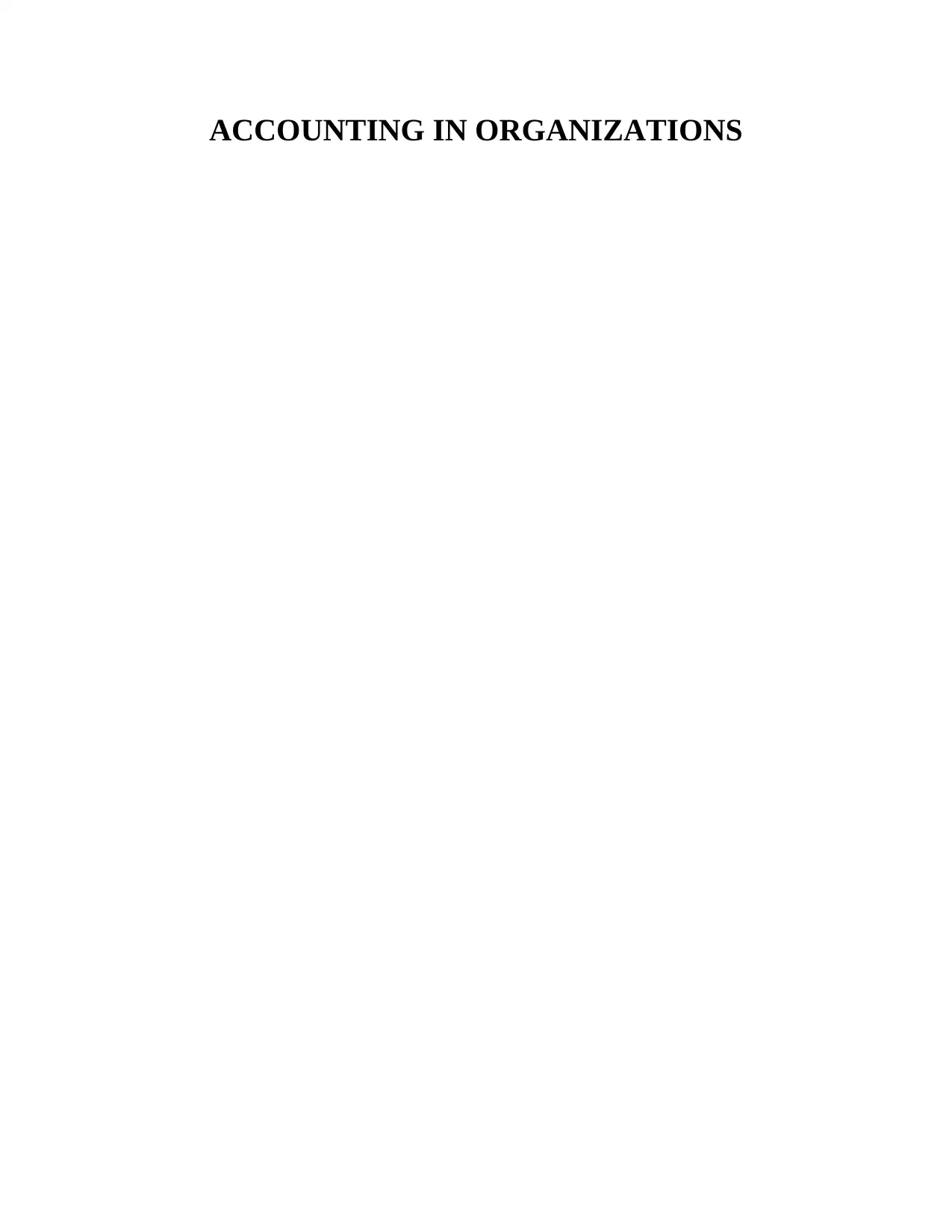
ACCOUNTING IN ORGANIZATIONS
Paraphrase This Document
Need a fresh take? Get an instant paraphrase of this document with our AI Paraphraser
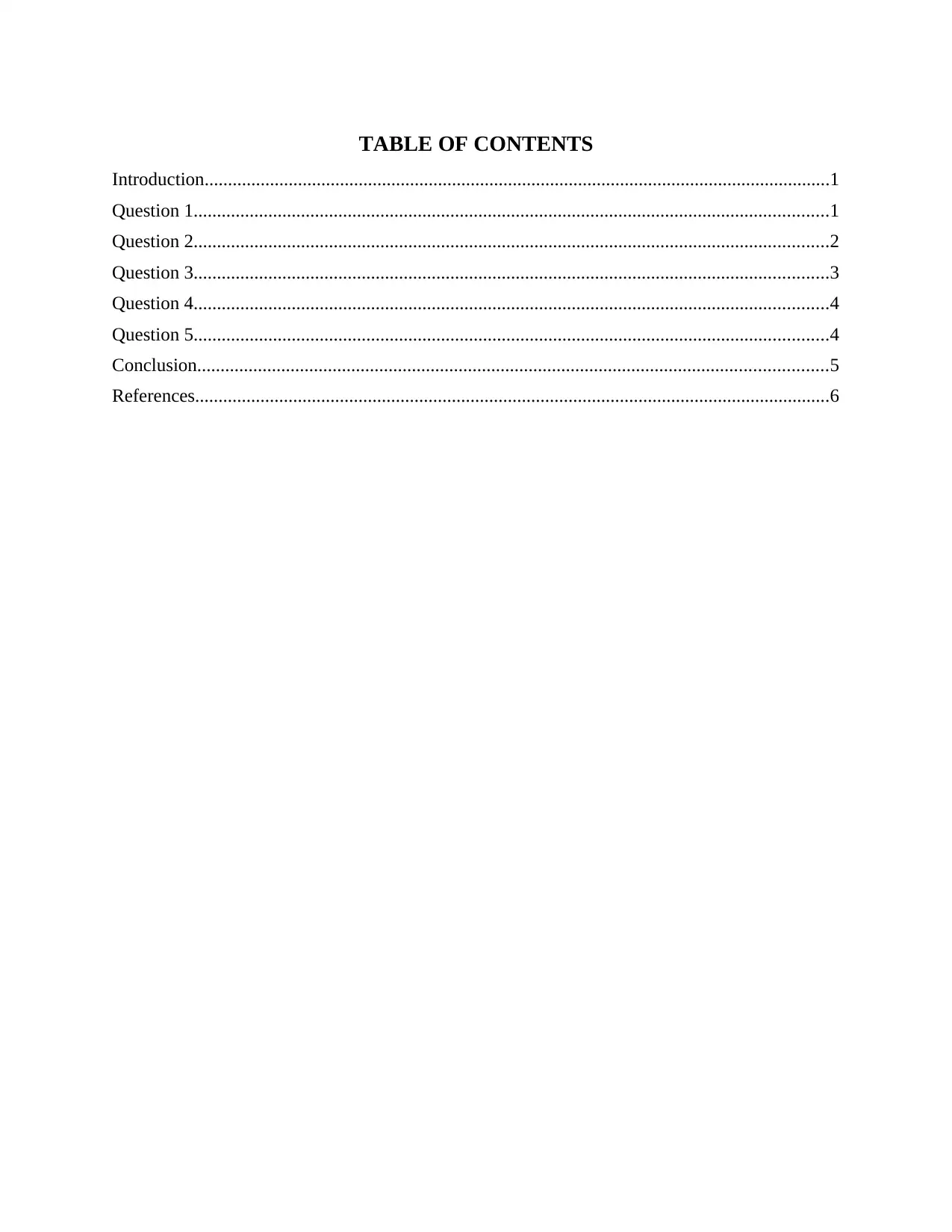
TABLE OF CONTENTS
Introduction......................................................................................................................................1
Question 1........................................................................................................................................1
Question 2........................................................................................................................................2
Question 3........................................................................................................................................3
Question 4........................................................................................................................................4
Question 5........................................................................................................................................4
Conclusion.......................................................................................................................................5
References........................................................................................................................................6
Introduction......................................................................................................................................1
Question 1........................................................................................................................................1
Question 2........................................................................................................................................2
Question 3........................................................................................................................................3
Question 4........................................................................................................................................4
Question 5........................................................................................................................................4
Conclusion.......................................................................................................................................5
References........................................................................................................................................6
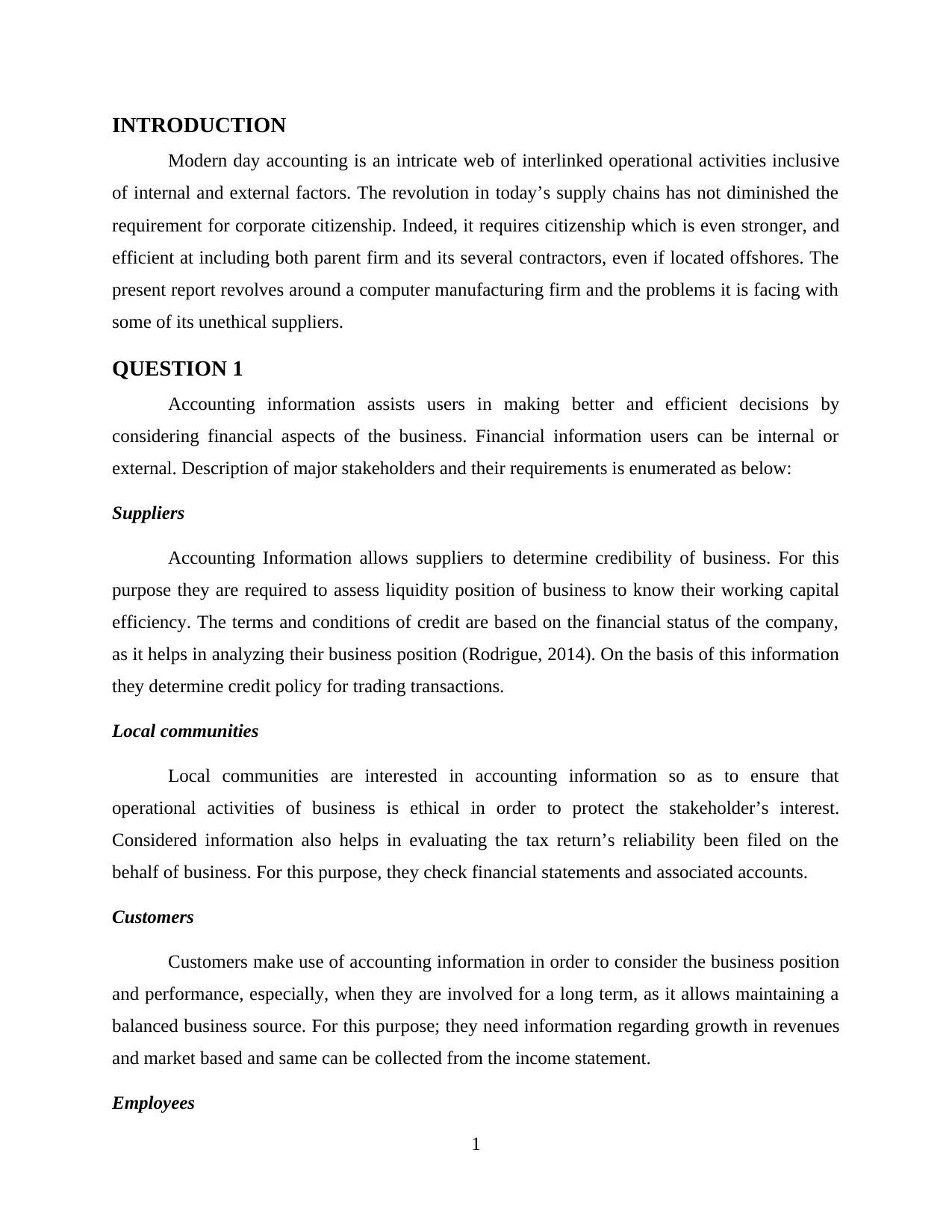
INTRODUCTION
Modern day accounting is an intricate web of interlinked operational activities inclusive
of internal and external factors. The revolution in today’s supply chains has not diminished the
requirement for corporate citizenship. Indeed, it requires citizenship which is even stronger, and
efficient at including both parent firm and its several contractors, even if located offshores. The
present report revolves around a computer manufacturing firm and the problems it is facing with
some of its unethical suppliers.
QUESTION 1
Accounting information assists users in making better and efficient decisions by
considering financial aspects of the business. Financial information users can be internal or
external. Description of major stakeholders and their requirements is enumerated as below:
Suppliers
Accounting Information allows suppliers to determine credibility of business. For this
purpose they are required to assess liquidity position of business to know their working capital
efficiency. The terms and conditions of credit are based on the financial status of the company,
as it helps in analyzing their business position (Rodrigue, 2014). On the basis of this information
they determine credit policy for trading transactions.
Local communities
Local communities are interested in accounting information so as to ensure that
operational activities of business is ethical in order to protect the stakeholder’s interest.
Considered information also helps in evaluating the tax return’s reliability been filed on the
behalf of business. For this purpose, they check financial statements and associated accounts.
Customers
Customers make use of accounting information in order to consider the business position
and performance, especially, when they are involved for a long term, as it allows maintaining a
balanced business source. For this purpose; they need information regarding growth in revenues
and market based and same can be collected from the income statement.
Employees
1
Modern day accounting is an intricate web of interlinked operational activities inclusive
of internal and external factors. The revolution in today’s supply chains has not diminished the
requirement for corporate citizenship. Indeed, it requires citizenship which is even stronger, and
efficient at including both parent firm and its several contractors, even if located offshores. The
present report revolves around a computer manufacturing firm and the problems it is facing with
some of its unethical suppliers.
QUESTION 1
Accounting information assists users in making better and efficient decisions by
considering financial aspects of the business. Financial information users can be internal or
external. Description of major stakeholders and their requirements is enumerated as below:
Suppliers
Accounting Information allows suppliers to determine credibility of business. For this
purpose they are required to assess liquidity position of business to know their working capital
efficiency. The terms and conditions of credit are based on the financial status of the company,
as it helps in analyzing their business position (Rodrigue, 2014). On the basis of this information
they determine credit policy for trading transactions.
Local communities
Local communities are interested in accounting information so as to ensure that
operational activities of business is ethical in order to protect the stakeholder’s interest.
Considered information also helps in evaluating the tax return’s reliability been filed on the
behalf of business. For this purpose, they check financial statements and associated accounts.
Customers
Customers make use of accounting information in order to consider the business position
and performance, especially, when they are involved for a long term, as it allows maintaining a
balanced business source. For this purpose; they need information regarding growth in revenues
and market based and same can be collected from the income statement.
Employees
1
⊘ This is a preview!⊘
Do you want full access?
Subscribe today to unlock all pages.

Trusted by 1+ million students worldwide
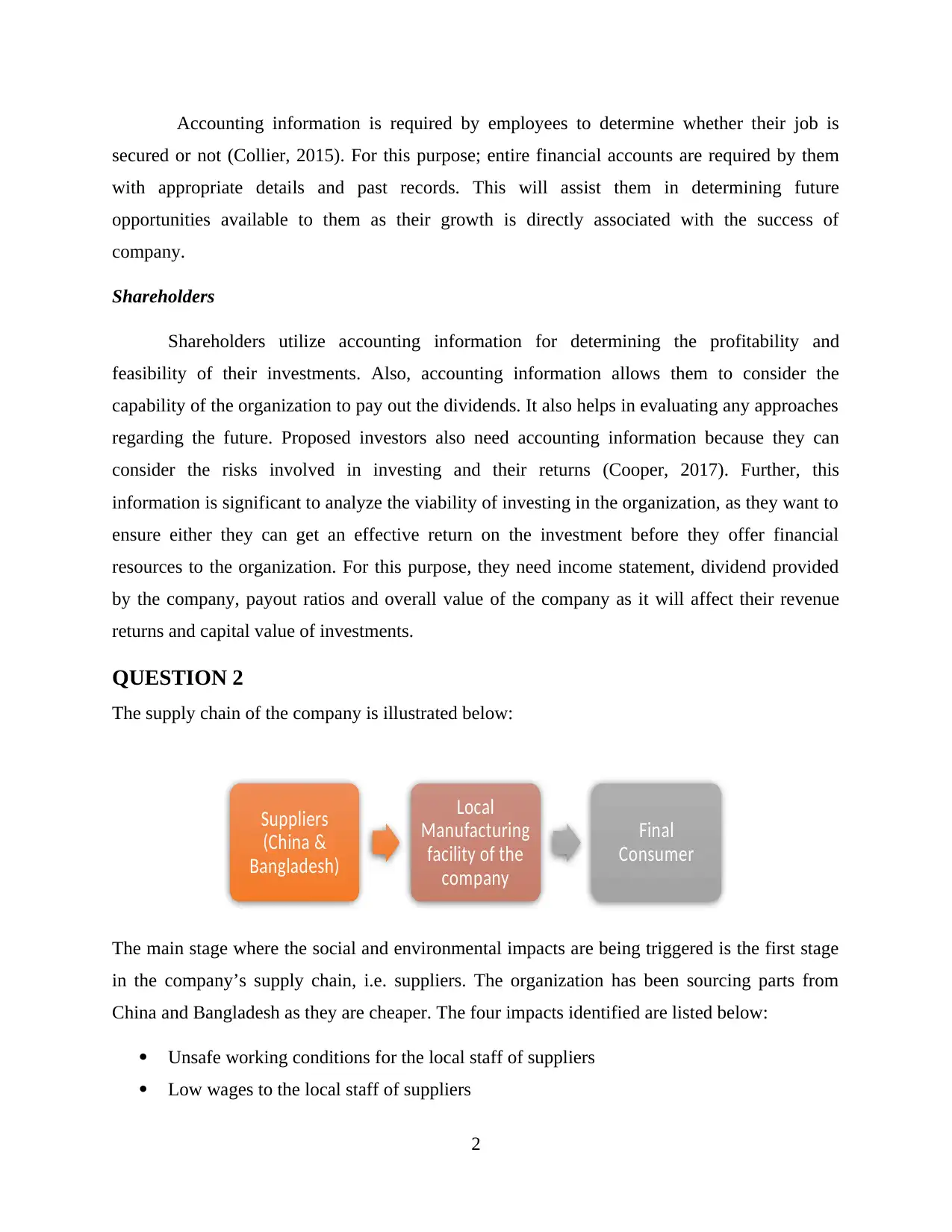
Accounting information is required by employees to determine whether their job is
secured or not (Collier, 2015). For this purpose; entire financial accounts are required by them
with appropriate details and past records. This will assist them in determining future
opportunities available to them as their growth is directly associated with the success of
company.
Shareholders
Shareholders utilize accounting information for determining the profitability and
feasibility of their investments. Also, accounting information allows them to consider the
capability of the organization to pay out the dividends. It also helps in evaluating any approaches
regarding the future. Proposed investors also need accounting information because they can
consider the risks involved in investing and their returns (Cooper, 2017). Further, this
information is significant to analyze the viability of investing in the organization, as they want to
ensure either they can get an effective return on the investment before they offer financial
resources to the organization. For this purpose, they need income statement, dividend provided
by the company, payout ratios and overall value of the company as it will affect their revenue
returns and capital value of investments.
QUESTION 2
The supply chain of the company is illustrated below:
The main stage where the social and environmental impacts are being triggered is the first stage
in the company’s supply chain, i.e. suppliers. The organization has been sourcing parts from
China and Bangladesh as they are cheaper. The four impacts identified are listed below:
Unsafe working conditions for the local staff of suppliers
Low wages to the local staff of suppliers
2
Suppliers
(China &
Bangladesh)
Local
Manufacturing
facility of the
company
Final
Consumer
secured or not (Collier, 2015). For this purpose; entire financial accounts are required by them
with appropriate details and past records. This will assist them in determining future
opportunities available to them as their growth is directly associated with the success of
company.
Shareholders
Shareholders utilize accounting information for determining the profitability and
feasibility of their investments. Also, accounting information allows them to consider the
capability of the organization to pay out the dividends. It also helps in evaluating any approaches
regarding the future. Proposed investors also need accounting information because they can
consider the risks involved in investing and their returns (Cooper, 2017). Further, this
information is significant to analyze the viability of investing in the organization, as they want to
ensure either they can get an effective return on the investment before they offer financial
resources to the organization. For this purpose, they need income statement, dividend provided
by the company, payout ratios and overall value of the company as it will affect their revenue
returns and capital value of investments.
QUESTION 2
The supply chain of the company is illustrated below:
The main stage where the social and environmental impacts are being triggered is the first stage
in the company’s supply chain, i.e. suppliers. The organization has been sourcing parts from
China and Bangladesh as they are cheaper. The four impacts identified are listed below:
Unsafe working conditions for the local staff of suppliers
Low wages to the local staff of suppliers
2
Suppliers
(China &
Bangladesh)
Local
Manufacturing
facility of the
company
Final
Consumer
Paraphrase This Document
Need a fresh take? Get an instant paraphrase of this document with our AI Paraphraser
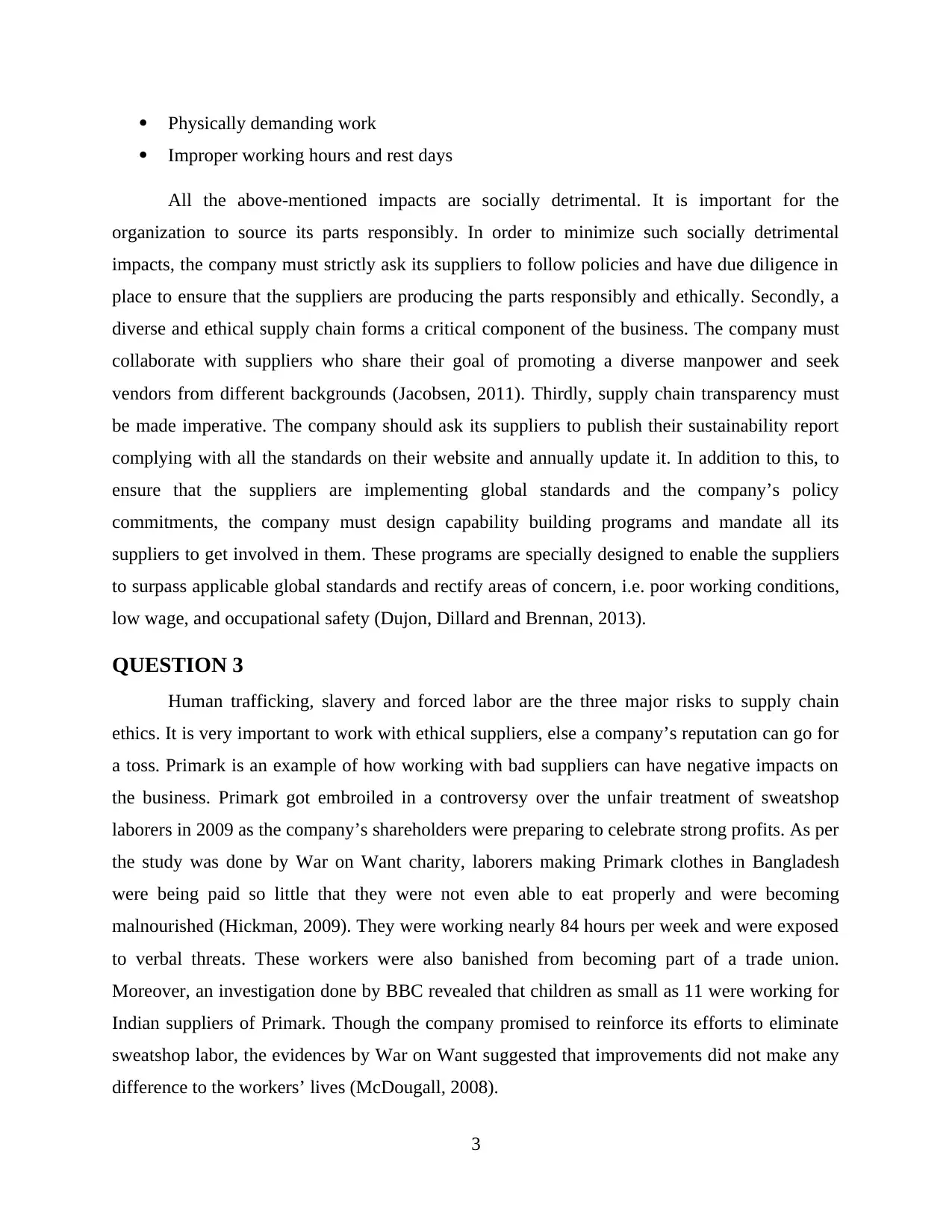
Physically demanding work
Improper working hours and rest days
All the above-mentioned impacts are socially detrimental. It is important for the
organization to source its parts responsibly. In order to minimize such socially detrimental
impacts, the company must strictly ask its suppliers to follow policies and have due diligence in
place to ensure that the suppliers are producing the parts responsibly and ethically. Secondly, a
diverse and ethical supply chain forms a critical component of the business. The company must
collaborate with suppliers who share their goal of promoting a diverse manpower and seek
vendors from different backgrounds (Jacobsen, 2011). Thirdly, supply chain transparency must
be made imperative. The company should ask its suppliers to publish their sustainability report
complying with all the standards on their website and annually update it. In addition to this, to
ensure that the suppliers are implementing global standards and the company’s policy
commitments, the company must design capability building programs and mandate all its
suppliers to get involved in them. These programs are specially designed to enable the suppliers
to surpass applicable global standards and rectify areas of concern, i.e. poor working conditions,
low wage, and occupational safety (Dujon, Dillard and Brennan, 2013).
QUESTION 3
Human trafficking, slavery and forced labor are the three major risks to supply chain
ethics. It is very important to work with ethical suppliers, else a company’s reputation can go for
a toss. Primark is an example of how working with bad suppliers can have negative impacts on
the business. Primark got embroiled in a controversy over the unfair treatment of sweatshop
laborers in 2009 as the company’s shareholders were preparing to celebrate strong profits. As per
the study was done by War on Want charity, laborers making Primark clothes in Bangladesh
were being paid so little that they were not even able to eat properly and were becoming
malnourished (Hickman, 2009). They were working nearly 84 hours per week and were exposed
to verbal threats. These workers were also banished from becoming part of a trade union.
Moreover, an investigation done by BBC revealed that children as small as 11 were working for
Indian suppliers of Primark. Though the company promised to reinforce its efforts to eliminate
sweatshop labor, the evidences by War on Want suggested that improvements did not make any
difference to the workers’ lives (McDougall, 2008).
3
Improper working hours and rest days
All the above-mentioned impacts are socially detrimental. It is important for the
organization to source its parts responsibly. In order to minimize such socially detrimental
impacts, the company must strictly ask its suppliers to follow policies and have due diligence in
place to ensure that the suppliers are producing the parts responsibly and ethically. Secondly, a
diverse and ethical supply chain forms a critical component of the business. The company must
collaborate with suppliers who share their goal of promoting a diverse manpower and seek
vendors from different backgrounds (Jacobsen, 2011). Thirdly, supply chain transparency must
be made imperative. The company should ask its suppliers to publish their sustainability report
complying with all the standards on their website and annually update it. In addition to this, to
ensure that the suppliers are implementing global standards and the company’s policy
commitments, the company must design capability building programs and mandate all its
suppliers to get involved in them. These programs are specially designed to enable the suppliers
to surpass applicable global standards and rectify areas of concern, i.e. poor working conditions,
low wage, and occupational safety (Dujon, Dillard and Brennan, 2013).
QUESTION 3
Human trafficking, slavery and forced labor are the three major risks to supply chain
ethics. It is very important to work with ethical suppliers, else a company’s reputation can go for
a toss. Primark is an example of how working with bad suppliers can have negative impacts on
the business. Primark got embroiled in a controversy over the unfair treatment of sweatshop
laborers in 2009 as the company’s shareholders were preparing to celebrate strong profits. As per
the study was done by War on Want charity, laborers making Primark clothes in Bangladesh
were being paid so little that they were not even able to eat properly and were becoming
malnourished (Hickman, 2009). They were working nearly 84 hours per week and were exposed
to verbal threats. These workers were also banished from becoming part of a trade union.
Moreover, an investigation done by BBC revealed that children as small as 11 were working for
Indian suppliers of Primark. Though the company promised to reinforce its efforts to eliminate
sweatshop labor, the evidences by War on Want suggested that improvements did not make any
difference to the workers’ lives (McDougall, 2008).
3
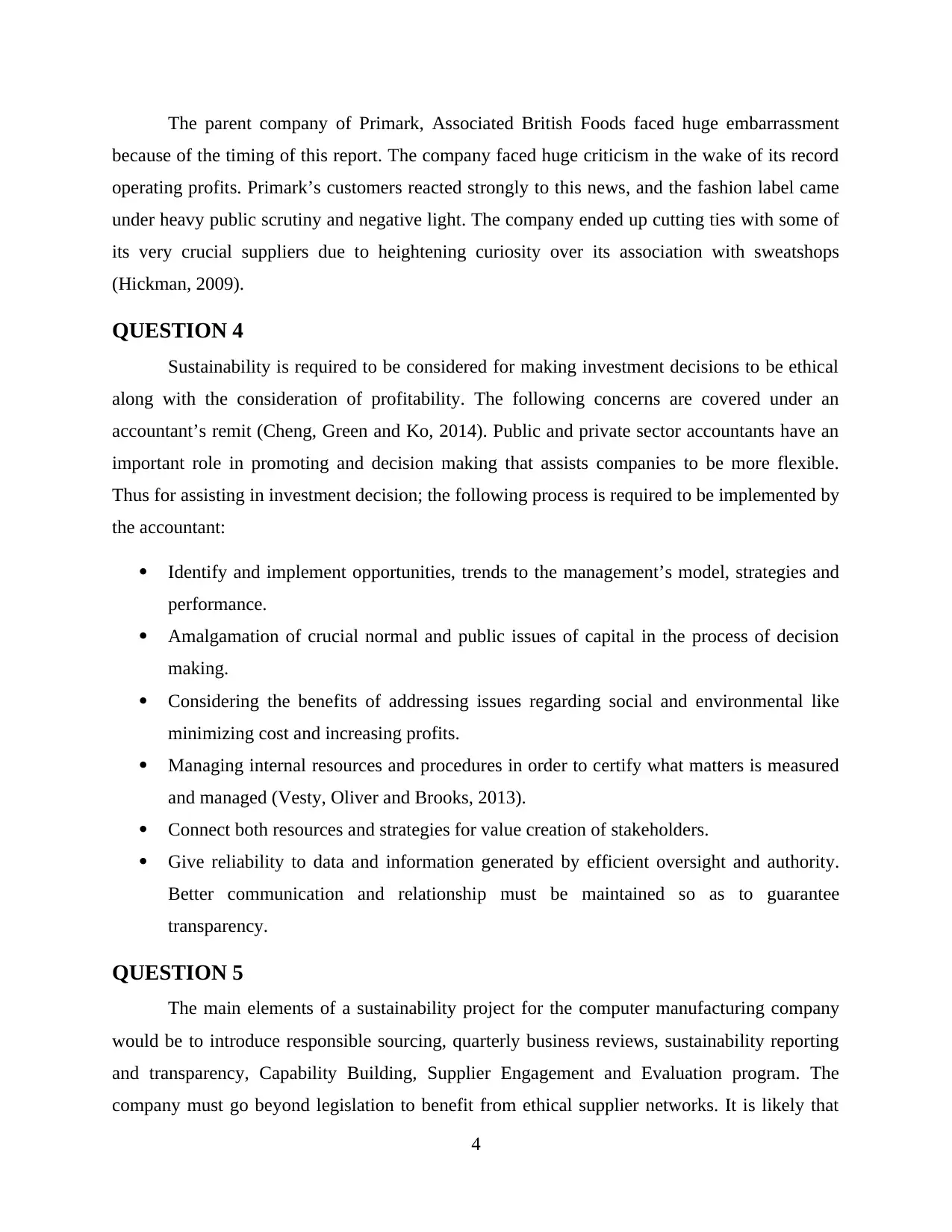
The parent company of Primark, Associated British Foods faced huge embarrassment
because of the timing of this report. The company faced huge criticism in the wake of its record
operating profits. Primark’s customers reacted strongly to this news, and the fashion label came
under heavy public scrutiny and negative light. The company ended up cutting ties with some of
its very crucial suppliers due to heightening curiosity over its association with sweatshops
(Hickman, 2009).
QUESTION 4
Sustainability is required to be considered for making investment decisions to be ethical
along with the consideration of profitability. The following concerns are covered under an
accountant’s remit (Cheng, Green and Ko, 2014). Public and private sector accountants have an
important role in promoting and decision making that assists companies to be more flexible.
Thus for assisting in investment decision; the following process is required to be implemented by
the accountant:
Identify and implement opportunities, trends to the management’s model, strategies and
performance.
Amalgamation of crucial normal and public issues of capital in the process of decision
making.
Considering the benefits of addressing issues regarding social and environmental like
minimizing cost and increasing profits.
Managing internal resources and procedures in order to certify what matters is measured
and managed (Vesty, Oliver and Brooks, 2013).
Connect both resources and strategies for value creation of stakeholders.
Give reliability to data and information generated by efficient oversight and authority.
Better communication and relationship must be maintained so as to guarantee
transparency.
QUESTION 5
The main elements of a sustainability project for the computer manufacturing company
would be to introduce responsible sourcing, quarterly business reviews, sustainability reporting
and transparency, Capability Building, Supplier Engagement and Evaluation program. The
company must go beyond legislation to benefit from ethical supplier networks. It is likely that
4
because of the timing of this report. The company faced huge criticism in the wake of its record
operating profits. Primark’s customers reacted strongly to this news, and the fashion label came
under heavy public scrutiny and negative light. The company ended up cutting ties with some of
its very crucial suppliers due to heightening curiosity over its association with sweatshops
(Hickman, 2009).
QUESTION 4
Sustainability is required to be considered for making investment decisions to be ethical
along with the consideration of profitability. The following concerns are covered under an
accountant’s remit (Cheng, Green and Ko, 2014). Public and private sector accountants have an
important role in promoting and decision making that assists companies to be more flexible.
Thus for assisting in investment decision; the following process is required to be implemented by
the accountant:
Identify and implement opportunities, trends to the management’s model, strategies and
performance.
Amalgamation of crucial normal and public issues of capital in the process of decision
making.
Considering the benefits of addressing issues regarding social and environmental like
minimizing cost and increasing profits.
Managing internal resources and procedures in order to certify what matters is measured
and managed (Vesty, Oliver and Brooks, 2013).
Connect both resources and strategies for value creation of stakeholders.
Give reliability to data and information generated by efficient oversight and authority.
Better communication and relationship must be maintained so as to guarantee
transparency.
QUESTION 5
The main elements of a sustainability project for the computer manufacturing company
would be to introduce responsible sourcing, quarterly business reviews, sustainability reporting
and transparency, Capability Building, Supplier Engagement and Evaluation program. The
company must go beyond legislation to benefit from ethical supplier networks. It is likely that
4
⊘ This is a preview!⊘
Do you want full access?
Subscribe today to unlock all pages.

Trusted by 1+ million students worldwide
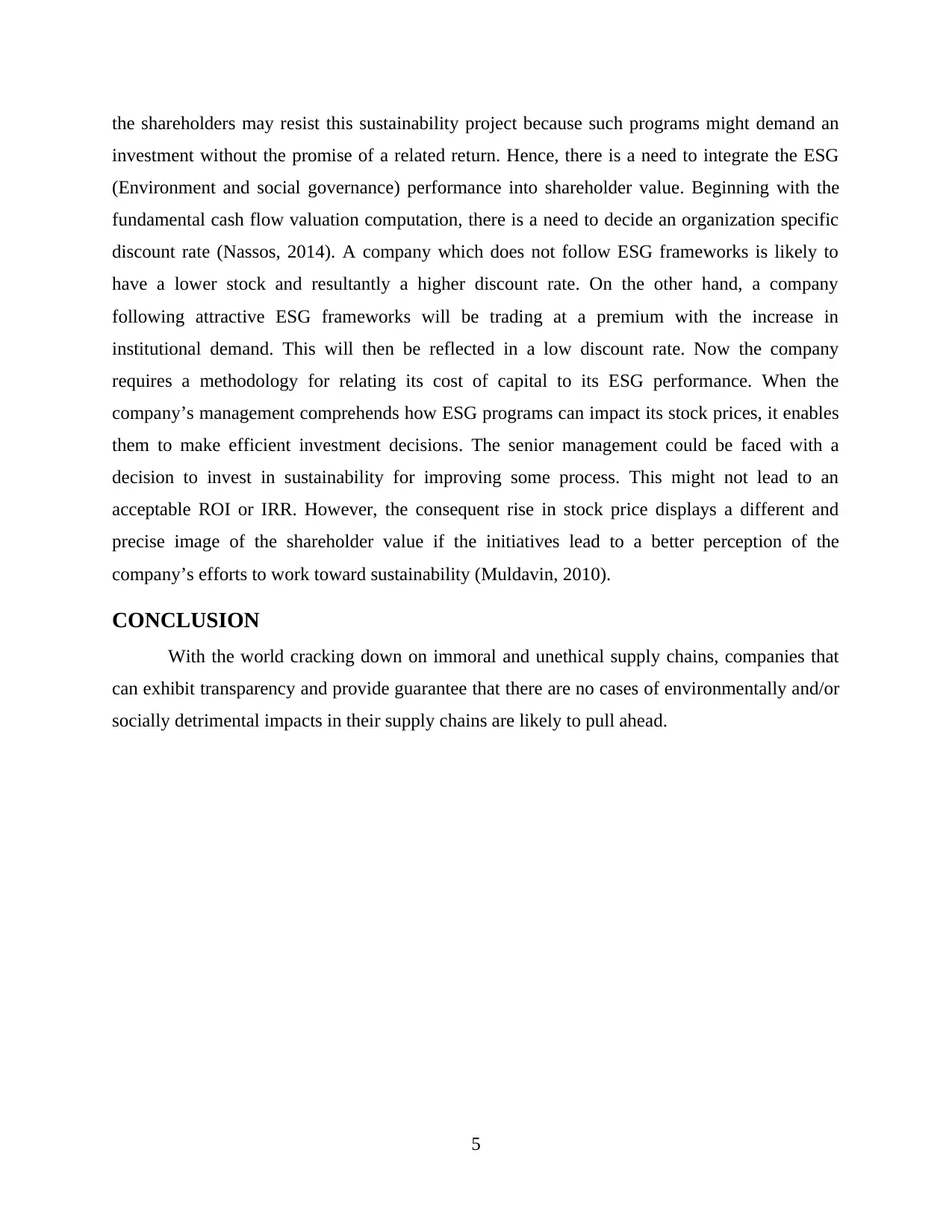
the shareholders may resist this sustainability project because such programs might demand an
investment without the promise of a related return. Hence, there is a need to integrate the ESG
(Environment and social governance) performance into shareholder value. Beginning with the
fundamental cash flow valuation computation, there is a need to decide an organization specific
discount rate (Nassos, 2014). A company which does not follow ESG frameworks is likely to
have a lower stock and resultantly a higher discount rate. On the other hand, a company
following attractive ESG frameworks will be trading at a premium with the increase in
institutional demand. This will then be reflected in a low discount rate. Now the company
requires a methodology for relating its cost of capital to its ESG performance. When the
company’s management comprehends how ESG programs can impact its stock prices, it enables
them to make efficient investment decisions. The senior management could be faced with a
decision to invest in sustainability for improving some process. This might not lead to an
acceptable ROI or IRR. However, the consequent rise in stock price displays a different and
precise image of the shareholder value if the initiatives lead to a better perception of the
company’s efforts to work toward sustainability (Muldavin, 2010).
CONCLUSION
With the world cracking down on immoral and unethical supply chains, companies that
can exhibit transparency and provide guarantee that there are no cases of environmentally and/or
socially detrimental impacts in their supply chains are likely to pull ahead.
5
investment without the promise of a related return. Hence, there is a need to integrate the ESG
(Environment and social governance) performance into shareholder value. Beginning with the
fundamental cash flow valuation computation, there is a need to decide an organization specific
discount rate (Nassos, 2014). A company which does not follow ESG frameworks is likely to
have a lower stock and resultantly a higher discount rate. On the other hand, a company
following attractive ESG frameworks will be trading at a premium with the increase in
institutional demand. This will then be reflected in a low discount rate. Now the company
requires a methodology for relating its cost of capital to its ESG performance. When the
company’s management comprehends how ESG programs can impact its stock prices, it enables
them to make efficient investment decisions. The senior management could be faced with a
decision to invest in sustainability for improving some process. This might not lead to an
acceptable ROI or IRR. However, the consequent rise in stock price displays a different and
precise image of the shareholder value if the initiatives lead to a better perception of the
company’s efforts to work toward sustainability (Muldavin, 2010).
CONCLUSION
With the world cracking down on immoral and unethical supply chains, companies that
can exhibit transparency and provide guarantee that there are no cases of environmentally and/or
socially detrimental impacts in their supply chains are likely to pull ahead.
5
Paraphrase This Document
Need a fresh take? Get an instant paraphrase of this document with our AI Paraphraser
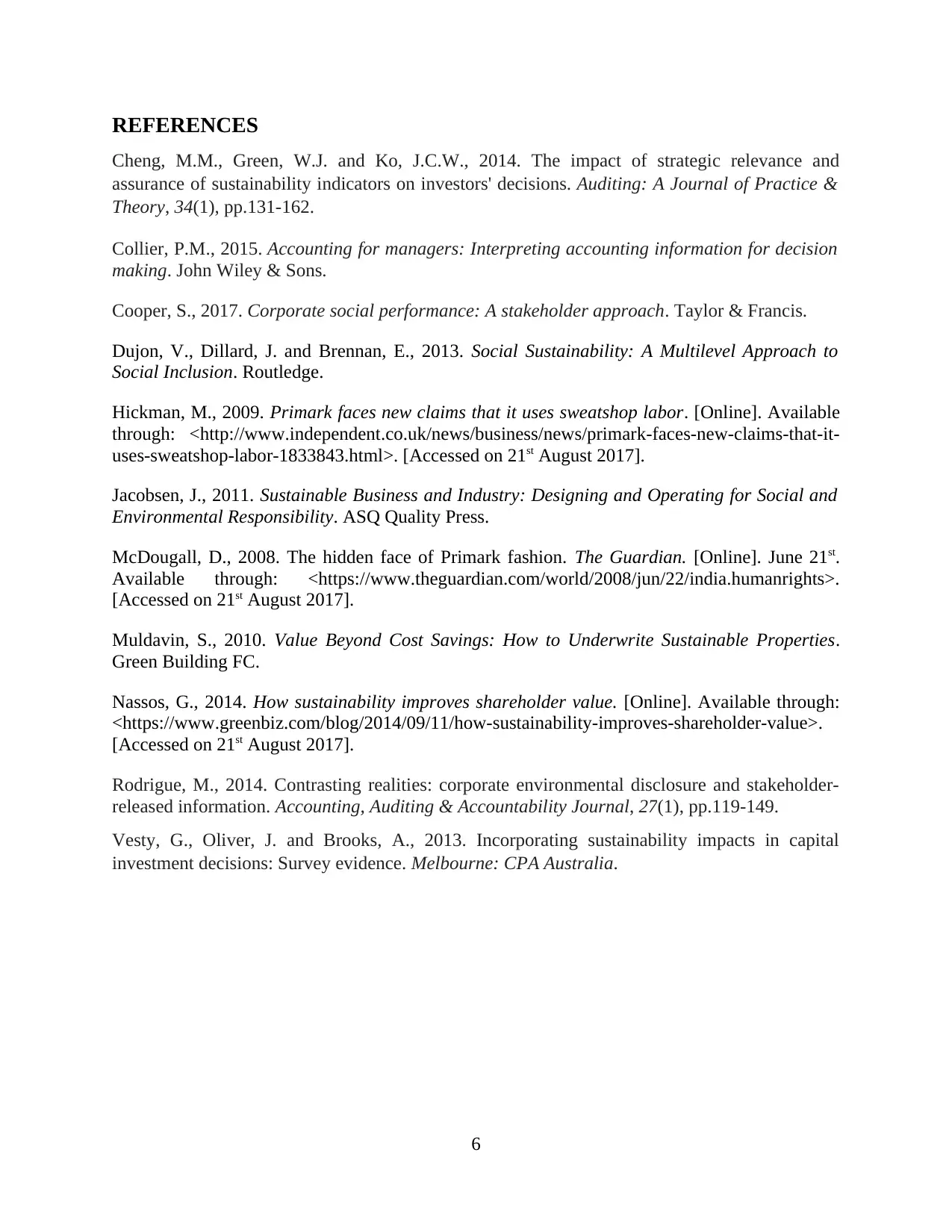
REFERENCES
Cheng, M.M., Green, W.J. and Ko, J.C.W., 2014. The impact of strategic relevance and
assurance of sustainability indicators on investors' decisions. Auditing: A Journal of Practice &
Theory, 34(1), pp.131-162.
Collier, P.M., 2015. Accounting for managers: Interpreting accounting information for decision
making. John Wiley & Sons.
Cooper, S., 2017. Corporate social performance: A stakeholder approach. Taylor & Francis.
Dujon, V., Dillard, J. and Brennan, E., 2013. Social Sustainability: A Multilevel Approach to
Social Inclusion. Routledge.
Hickman, M., 2009. Primark faces new claims that it uses sweatshop labor. [Online]. Available
through: <http://www.independent.co.uk/news/business/news/primark-faces-new-claims-that-it-
uses-sweatshop-labor-1833843.html>. [Accessed on 21st August 2017].
Jacobsen, J., 2011. Sustainable Business and Industry: Designing and Operating for Social and
Environmental Responsibility. ASQ Quality Press.
McDougall, D., 2008. The hidden face of Primark fashion. The Guardian. [Online]. June 21st.
Available through: <https://www.theguardian.com/world/2008/jun/22/india.humanrights>.
[Accessed on 21st August 2017].
Muldavin, S., 2010. Value Beyond Cost Savings: How to Underwrite Sustainable Properties.
Green Building FC.
Nassos, G., 2014. How sustainability improves shareholder value. [Online]. Available through:
<https://www.greenbiz.com/blog/2014/09/11/how-sustainability-improves-shareholder-value>.
[Accessed on 21st August 2017].
Rodrigue, M., 2014. Contrasting realities: corporate environmental disclosure and stakeholder-
released information. Accounting, Auditing & Accountability Journal, 27(1), pp.119-149.
Vesty, G., Oliver, J. and Brooks, A., 2013. Incorporating sustainability impacts in capital
investment decisions: Survey evidence. Melbourne: CPA Australia.
6
Cheng, M.M., Green, W.J. and Ko, J.C.W., 2014. The impact of strategic relevance and
assurance of sustainability indicators on investors' decisions. Auditing: A Journal of Practice &
Theory, 34(1), pp.131-162.
Collier, P.M., 2015. Accounting for managers: Interpreting accounting information for decision
making. John Wiley & Sons.
Cooper, S., 2017. Corporate social performance: A stakeholder approach. Taylor & Francis.
Dujon, V., Dillard, J. and Brennan, E., 2013. Social Sustainability: A Multilevel Approach to
Social Inclusion. Routledge.
Hickman, M., 2009. Primark faces new claims that it uses sweatshop labor. [Online]. Available
through: <http://www.independent.co.uk/news/business/news/primark-faces-new-claims-that-it-
uses-sweatshop-labor-1833843.html>. [Accessed on 21st August 2017].
Jacobsen, J., 2011. Sustainable Business and Industry: Designing and Operating for Social and
Environmental Responsibility. ASQ Quality Press.
McDougall, D., 2008. The hidden face of Primark fashion. The Guardian. [Online]. June 21st.
Available through: <https://www.theguardian.com/world/2008/jun/22/india.humanrights>.
[Accessed on 21st August 2017].
Muldavin, S., 2010. Value Beyond Cost Savings: How to Underwrite Sustainable Properties.
Green Building FC.
Nassos, G., 2014. How sustainability improves shareholder value. [Online]. Available through:
<https://www.greenbiz.com/blog/2014/09/11/how-sustainability-improves-shareholder-value>.
[Accessed on 21st August 2017].
Rodrigue, M., 2014. Contrasting realities: corporate environmental disclosure and stakeholder-
released information. Accounting, Auditing & Accountability Journal, 27(1), pp.119-149.
Vesty, G., Oliver, J. and Brooks, A., 2013. Incorporating sustainability impacts in capital
investment decisions: Survey evidence. Melbourne: CPA Australia.
6
1 out of 8
Related Documents
Your All-in-One AI-Powered Toolkit for Academic Success.
+13062052269
info@desklib.com
Available 24*7 on WhatsApp / Email
![[object Object]](/_next/static/media/star-bottom.7253800d.svg)
Unlock your academic potential
Copyright © 2020–2025 A2Z Services. All Rights Reserved. Developed and managed by ZUCOL.





